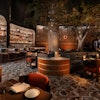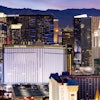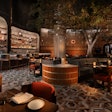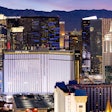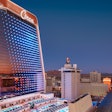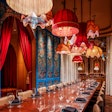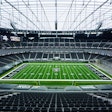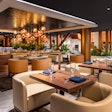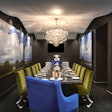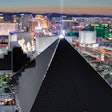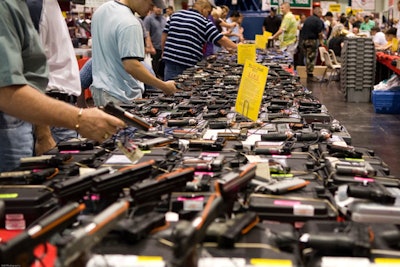
Every weekend, dozens of gun shows take place across the country. During the last weekend in September, some 34 shows were held in venues, spanning Ohio to California. That was also the same weekend the deadliest mass shooting in U.S. history happened in Las Vegas. But whether that attack will have any impact on the steady rise of gun shows remains to be seen.
In a report published in 2007, the Bureau of Alcohol, Tobacco, Firearms, and Explosives estimated that there were 2,000 to 5,200 gun shows in the U.S. a year, and that most shows saw between 2,500 to 15,000 attendees over a two-day period. The number of vendor tables ranged from 50 to as many as 2,000, with the largest gun shows selling more than 1,000 firearms in one weekend.
This proliferation wasn’t always the case though. In 1986, Congress passed the Firearm Owners’ Protection Act (FOPA), enabling dealers to “conduct business temporarily at a location other than the location specified on the license” a.k.a., at a gun show. Before that, retailers were only able to show and not sell at these types of shows.
How They Work
Usually organized by commercial promoters such as Crossroads of the West Gun Shows, the events offer a variety of new and used firearms, including rifles, shotguns, and antique collectibles, as well as gun-related paraphernalia such as parts and ammunition and other goods like jewelry and beef jerky. Oftentimes, smaller, regional shows are held at the same public venue like a fairgrounds or convention center, usually at regular intervals such as monthly. Licensed retailers and unlicensed vendors rent space for as much as $80 per table, while attendees generally pay a nominal fee for admission.
Carrie Lightfoot, owner and founder of the Well Armed Woman, said that the shows are run “in the same manner logistically as trade shows in any industry.” Her Scottsdale, Arizona-based company has exhibited at both local gun shows and large national ones such as the N.R.A. Annual Meeting and Exhibits where she showcases and sells concealed carry holsters designed for women, along with gear and apparel. “I feel it is an effective way to reach women gun owners face to face,” she explained. “Because there are so few resources and products designed specifically to meet their needs, show attendees are thrilled to have products they can touch and try out and on, plus [they are] connecting with knowledgeable women they can talk to and ask questions.”
Who Attends
Traditionally, the average gun show audience is white males, but Lightfoot said that “there has been a shift in recent years to become more women-friendly, with an increase in female-focused exhibitors and a desire to attract more female attendees. For the larger shows in particular, we are seeing much less of the ‘sexualized’ side of the industry and a more respectful representation of the female shooter.”
Two gun-show attendees spoke with BizBash but asked that their full identities remain anonymous. Gretchen, a 40-year-old female gun-show attendee from Allentown, Pennsylvania, explained that the shows “are basically set up like flea markets indoors…. Most vendors sell different types of guns and gun accessories like straps and different grips and scopes. Other vendors sell knives and army type gear.” As for anything out of the ordinary, she said “nothing really shocking there except a pickle stand. In the middle of gun tables. So weird.”
Pickles aside, the shows still contain some disturbing elements—“gun nuts,” white supremacy propaganda, and tables of assault weapons—that can make some attendees feel uneasy.
Chris of Cedar Park, Texas, a 50-year-old gun owner who has attended a few shows since moving to the state six years ago, said that the shows are a good resource for learning about the newest products on the market, but added that he hasn’t been to one in over a year because “they have become pretty uncomfortable to attend.” He pointed to the rise in fervent gun-rights advocates as the main reason for his absence. “Most of the vendors at those shows and even a lot of the attendees, to be perfectly frank, are just so intense about it. [Gun-show organizers] would be a lot more successful if they could find a way to make it seem less intense in terms of the stridency of the vendors and the attendees. Make it a little more comfortable for people who might be new to guns or are a little nervous about it and I think you’d wind up with a lot more people showing up.”
Although gun-show popularity is a hard number to calculate, attendance does not seem to be declining. This year’s Shooting, Hunting, and Outdoor Trade Show (also known as the SHOT Show) boasted an attendance of nearly 65,000, surpassing last year’s turnout and making it the second-most attended show ever. Owned and operated by the National Shooting Sports Foundation, the show, which is a business-to-business event for those in the industry and the fifth-largest trade show in Las Vegas, features more than 6.5 million pounds of guns, gear, and exhibits for hunting, shooting, and fishing and is held every January at the Sands Expo Center—four miles away from the site of the October 1 shooting. Despite that, the Newtown, Connecticut-based group reportedly has no plans to change the venue or location.
The foundation would not offer comment on the show, and instead issued a general statement saying: “Our thoughts and prayers are with the families and loved ones of all those killed and injured in the criminal attack in Las Vegas. Out of respect for the families of the victims and the law enforcement process, we are not going to comment or participate in media requests made relating to this attack.”
What's the Gun Show Loophole?
So far, none of Vegas shooter Stephen Paddock’s rifle and handgun purchases have been traced back to a gun show. But not all gun-show sales have a paperwork trail. Unlicensed vendors and individual attendees are not required to perform background checks, record the sale, or ask for identification for private-party transactions, depending on the individual state law. For example, Maryland requires background checks for all gun sales, but Pennsylvania only requires background checks on handguns, not long guns or shotguns. This is commonly known as the gun show loophole.
Last year, Nevada voters tried to close this loophole by approving a ballot measure to require background checks for gun sales between private individuals. It requires both the buyer and seller to appear before a federally licensed firearms dealer to request a background check. But state and federal officials continue to battle over how it should be enforced.
When Chris purchased his pistol at a gun show, he was required to fill out a two-page federal background check form, as well as submit his driver’s license and social security number. He said that he found it unsettling that some attendees were able to buy a gun without a background check.
As is the fear of many, he believes the recent shooting will actually be good for the gun-show business. “Right now, after this event in Las Vegas, you’ll see a spike in sales. Because everyone panics and thinks, 'The government is going to stop letting me buy guns. So I better stock up. Because I only have 17 guns and I gotta get that 18th.'"
Correction: The original version of this article incorrectly reported that the National Shooting Sports Foundation organizes public gun shows. The NSSF sponsors the Shooting, Hunting, and Outdoor Trade Show. which is a business-to-business event for companies and their employees in the shooting, hunting, and outdoor trade.
